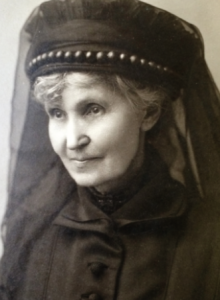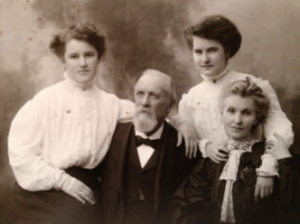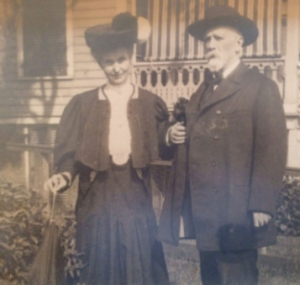Reflections of a Fenian widow: Mary Jane O’Donovan Rossa
Published in Issue 4 (July/August 2015), Volume 23No matter how difficult life became, she never wavered in her belief that what she and her husband did to gain freedom for Ireland was their most important work.

The widowed Mary Jane O’Donovan Rossa in August 1915. Daughter of Maxwell Irwin, a Young Irelander, she was publishing her own nationalistic poetry in the Irish People when she met her future husband in 1863 at the age of eighteen.
On 4 May 1916, responding to early reports of the executions of the Easter rebels, Mary Jane O’Donovan Rossa wrote to her daughter Daisy: ‘This week is like an awful nightmare … I am fearfully distressed by the news from Ireland, I feel heartbroken for I knew those gallant men who have been slaughtered’. Her anguish was the culmination of more than 50 years of working for Irish independence.
Mary Jane, the daughter of Maxwell Irwin, a Young Irelander, was publishing her own nationalist-ic poetry in the Irish People when she met her future husband in 1863 at the age of eighteen. One of those poems, ‘The Other Lover’, describes the role she took in her marriage, playing second fiddle to his patriotism. She went on to be, as John Devoy would later describe her in the Gaelic American at the time of her death, ‘an ideal patriot’s wife’. Her married life brought her the joy of thirteen children, the suffering of her husband’s imprisonment, and the tumultuous life with Rossa for over 50 years. But these were certainly not her only accomplishments. She was a skilled lecturer and writer: a reflector of the patriotism, hope and fight for Ireland carried on at home and in the United States. She loved the ‘Other Lover’ as strongly as did her husband, and the writings she left behind give us a glimpse into this passion.
When, aged eighteen, she married the 34-year-old Rossa, he was widowed with five sons. It was a surprise to her parents, who had greater expectations for their well-educated daughter. After only a year of marriage, her parents’ fears were realised; Rossa was arrested, as he was one of the Fenian leaders in Dublin. Her strength, however, was readily apparent. Mary Jane and Mrs Thomas Clarke Luby, wife of another leading Fenian, began the Ladies’ Committee, raising and distributing funds for the families left behind by the nearly 3,000 men arrested. Although only nineteen and pregnant, Mary Jane became secretary of the organisation, travelling throughout Ireland and carrying messages to England for the remaining Fenian leadership prior to the failed 1867 rebellion. Rossa would later write of his years in prison, but for Mary Jane the isolation of no letters and only two visits to him in two years added to her burdens. She worked feverishly for his release to no avail, for Rossa was sentenced to life imprisonment. Faced with poverty and limited prospects, she set out for America, leaving her children in Cork with her parents. In a letter to her daughter in 1916, she would remark how important it was to be productive, saying, ‘I always felt I earned my living’, as she had done since early in her marriage.
North American speaking tour
After some brief training with Frobisher, a well-known elocutionist in New York City, she became a sensation in the Irish-American communities as she crossed the United States giving lectures and readings. After her first event in New York City, where she was introduced by Horace Greeley, she travelled constantly for two years. Her repertoire included some American favourites such as ‘Sheridan’s Ride’ and ‘Barbara Fritchie’, but her own poetry and patriotic Irish stories were her mainstay. Her events were covered in great detail by the newspapers of the day, and she ventured south to Savannah, as far west as Omaha, and north to both Montreal and Toronto, all the while sending enough money home to support her extended family. In 1868 Irish lyrical poems, her collection of poetry, was published, adding to both her reputation and her finances. Her simple approach to Irish nationalism was one of the few areas of common ground appreciated by all the disagreeing parties in American Fenianism at that time.
Isaac Butt’s Amnesty Association was beginning to draw large crowds to mass meetings in Ireland. Its goal was the release of the Fenian prisoners still held. Mary Jane, who wanted to help in the efforts to release the prisoners, had returned to Ireland in early 1870 to give lectures and readings throughout Ireland and England, both with the Amnesty Association and on her own. At 23 she was a major celebrity amongst the nationalist Irish. She worked diligently for her husband’s release and spent months waiting to see him at Chatham Prison in England. He was released and exiled from Ireland in January 1871, and with four other senior Fenian leaders, including John Devoy, sailed to America on the Cuba. Their arrival was met with ceremonies and parades attended by 300,000 people, as the New York Herald at the time estimated.
Wifely role in the background
When the family settled in New York City, Mary Jane took the wifely role in the background while Rossa became the outspoken agitator that history remembers. Occasionally, when Rossa’s business endeavours fell short or when his passion for politics left the family in difficulties, Mary Jane again took to the lecture circuit. Moreover, behind the scenes she was a force in most of Rossa’s publications, independently writing and publishing his newspaper, the United Irishman, when he was travelling or ill.

Jeremiah and Mary Jane with their two daughters, Daisy (Margaret) and Jenny (Jane), in 1905 while living in Cork. (NLI)
Their years in the United States are well documented, as Rossa joined and argued with Clan na Gael or instigated the Skirmishing Fund. An assassination attempt on Rossa’s life made national headlines in Ireland and England as well as in the United States, and political caricatures of him were widely published. Mary Jane quietly raised their children and worked within social circles to balance her husband’s impetuous nature. She had thirteen children, of which only seven grew to adulthood. Her life was punctuated by sorrow and joy with her family. She was the steady presence, the calming influence. No matter how difficult life became, however, she never wavered in her belief that what she or her husband did to gain freedom for Ireland was their most important work.
After nearly twenty years of exile, Rossa was permitted to return to Ireland in 1894. On his second trip, in 1905, Rossa was offered a position by Cork City Council and hoped to remain in Ireland, but Mary Jane became seriously ill and they returned to their home in Staten Island, New York. Mary Jane was more at home surrounded by her children and grandchildren, and in New York she recovered from her illness.
Over the next few years Rossa’s health declined, and Mary Jane became not only the full-time editor and publisher of the United Irishman but her husband’s nurse as well. Her nursing duties kept her close to home, but she writes in letters to her daughter how refreshed she was after attending a Gaelic celebration in March 1915. She continued to correspond with many in the nationalist community; her letters carry many messages about hearing from old friends and keeping Rossa’s fierce patriotism alive in the people he touched. She also helped to heal the fractured friendship between Rossa and Devoy that had been severed very publicly many years before. She believed that their shared love of Ireland was more important than any past disagreements.
When Rossa died on 29 June 1915, Mary Jane quickly made arrangements for a burial in Ireland, as she had promised her husband 40 years before. After a well-attended and publicised funeral in Staten Island, she and her daughter Eileen went to Dublin with the body. As Mary Jane later wrote in the Gaelic American, the number of people attending, telegrams sent and resolutions received suggested that Rossa’s death ‘had evoked a tidal wave of patriotism; the spontaneous tribute’ that ‘might help the cause for which he had lived’. The decision was then made to bury Rossa in Glasnevin Cemetery, where his wife believed ‘the lesson of his life would constantly appeal to the hearts of thousands of his loving countrymen and women, prolonging after death his powers to circumvent and worry the English government in Ireland’.

Mary Jane and Jeremiah c. 1906 at their home on Staten Island, New York. (O’Donovan Rossa family)
Funeral a week-long event
Rossa’s funeral on 1 August 1915 was organised by Tom Clarke, Patrick Pearse and James Connolly and was the first show of solidarity and force by the Irish Republican Brotherhood, the Citizen Army and the Irish Volunteers. The graveside oration given by Patrick Pearse remains one of the most famous speeches in Irish history.
While in Dublin for the funeral, Mary Jane and Eileen were escorted nearly everywhere by Kathleen Daly Clarke and her sons Tomas, Emmet and Daly. Mary Jane was particularly moved by visits to Cumann na mBan meetings, where Mrs Clarke was an officer. She later reflected that here were ‘young schoolgirls and mothers and grandmothers learning to be soldiers … that they, too, may help their mother Erin without restriction … the most wonderful sign of the times’. After the Cumann na mBan meeting, she met with Countess Markievicz and members of Fianna Éireann. Mary Jane described the countess as ‘that picturesque and versatile lady, the Patron Saint of the Fianna Boys … tall and fair, young and golden haired, with bright blue eyes of soldier keenness, and wild rose complexion, dashing, and boyish, recklessly brave, yet appealingly feminine’.
The funeral was nearly a week-long event: a solemn Requiem High Mass at the Pro-Cathedral, followed by lying in state at City Hall, where thousands passed before the body for three days. Father Michael O’Flanagan of Cliffoney, Co. Sligo, a well-known member of the Gaelic League, gave a stirring oration in the final ceremonies at City Hall, and Mary Jane asked Tom Clarke, Rossa’s dear friend, to close the lid of the casket for the last time. Afterwards, she and Eileen had their photo taken with Clarke and O’Flanagan to commemorate the event. Writing about the funeral a few weeks later, Mary Jane recounts that she made many friends that week; in addition to the Clarkes and the countess, she mentions Thomas MacDonagh, The O’Rahilly, Joseph Plunkett, Eamon de Valera, Ned Daly and Patrick Pearse—so many who, just a year later, she mourned.
Reaction to the Easter Rising
When Mary Jane wrote to her daughter Daisy on 4 May 1916, she had just read the New York Times headline that morning: ‘Pearse, Clark, MacDonagh, and probably Connolly shot in the Tower’. She reflects in pain on
‘… those gallant men who have been slaughtered in the Tower of London [sic] by the savage English government and they were the bravest and noblest and simplest of true patriots who loved and venerated your father and were strengthened in their purpose by his teachings and example. They knew they were facing death in the struggle for their country’s freedom but they had no premonition that they would be shot on sight without the ministrations of their Church or human burial.’
 She describes the ‘savage English law [that] called in troops and turned machine guns on the people as well … so many wounded, so many dead, of all the lovely people who were so kind to Eileen and me last year and who buried your father as if he were a king’. She signs herself ‘your sorrowful Ducky’, her pet name from her children.
She describes the ‘savage English law [that] called in troops and turned machine guns on the people as well … so many wounded, so many dead, of all the lovely people who were so kind to Eileen and me last year and who buried your father as if he were a king’. She signs herself ‘your sorrowful Ducky’, her pet name from her children.
After Rossa’s death, Mary Jane had led a quieter life, but spurred on by these tragic events in Dublin she became more active. Ten days after writing this letter she donated the Irish flag from Rossa’s funeral to be used at a gathering in New York to commemorate the executions; 3,500 people assembled in Carnegie Hall, while 4,000 waited outside. She again wrote articles and poetry, and hosted some supporters in her home for meetings and fund-raising. Unfortunately, at a time when John Devoy thought her importance to the cause of Ireland as great as ever, it was to be short-lived. On 17 August 1916, Mary Jane died of a heart attack. Her sudden passing was noted well by John Devoy but hardly mentioned in the mainstream press. She was an unusual woman for her time. More than the patriot’s wife, she was a force in her own right, whose reflections of her times are so valuable to us nearly 100 years later.
Judith E. Campbell is a retired senior business executive and a current doctoral candidate at Drew University, New Jersey.
Further reading
J. Devoy, Recollections of an Irish rebel (Shannon, 1969).
J. O’Donovan Rossa, Irish rebels in English prisons: a record of prison life (Kenmare, 1878).
M. O’Donovan Rossa, My father and mother were Irish (New York, 1939).


















